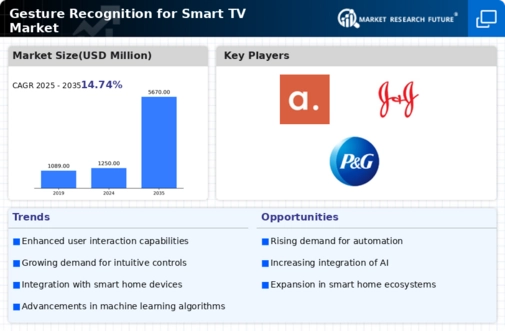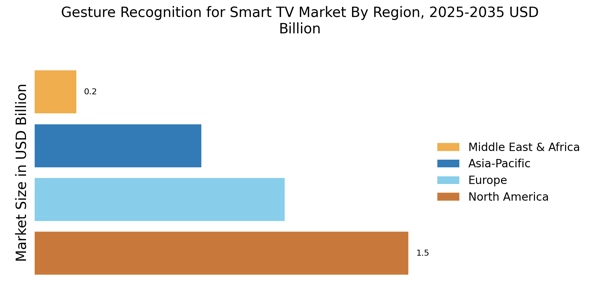Integration with Smart Home Ecosystems
The Gesture Recognition for Smart TV Market is increasingly influenced by the integration of smart TVs into broader smart home ecosystems. As consumers invest in interconnected devices, the ability to control smart TVs through gestures enhances the overall user experience. This integration allows for seamless interaction with various smart home devices, such as lighting and security systems, through simple gestures. Market analysis shows that households with smart home devices are 40% more likely to adopt gesture recognition features in their smart TVs. This trend indicates a growing synergy between gesture recognition technology and smart home integration, positioning it as a key driver in the industry.
Rising Demand for Enhanced User Experience
The Gesture Recognition for Smart TV Market is significantly driven by the rising demand for enhanced user experiences. Consumers are increasingly seeking intuitive and engaging ways to interact with their smart TVs, moving beyond traditional remote controls. Gesture recognition technology offers a unique solution, allowing users to navigate content and control settings with simple hand movements. Market Research Future suggests that user experience improvements can lead to a 30% increase in customer satisfaction ratings. As manufacturers prioritize user-centric designs, the adoption of gesture recognition features is likely to accelerate, making it a crucial driver in the industry.
Expansion of Content and Application Offerings
The Gesture Recognition for Smart TV Market is also propelled by the expansion of content and application offerings that leverage gesture-based controls. As streaming services and applications become more diverse, the need for innovative interaction methods grows. Gesture recognition allows users to navigate through vast libraries of content effortlessly, enhancing engagement and satisfaction. Data indicates that applications designed with gesture controls see a 25% higher user retention rate compared to traditional interfaces. This trend suggests that the expansion of content offerings, combined with gesture recognition technology, is likely to drive growth in the industry.
Technological Advancements in Gesture Recognition
The Gesture Recognition for Smart TV Market is experiencing a surge due to rapid technological advancements. Innovations in machine learning and computer vision are enhancing the accuracy and responsiveness of gesture recognition systems. As a result, manufacturers are increasingly integrating these technologies into smart TVs, allowing for more intuitive user interactions. The market is projected to grow at a compound annual growth rate of approximately 20% over the next five years, driven by these advancements. Enhanced gesture recognition capabilities not only improve user experience but also open new avenues for content interaction, making it a pivotal driver in the Gesture Recognition for Smart TV Market.
Growing Consumer Preference for Touchless Interfaces
In the Gesture Recognition for Smart TV Market, there is a notable shift towards touchless interfaces as consumers seek more hygienic and convenient ways to interact with their devices. This trend is particularly relevant in environments where physical contact with surfaces is minimized. The demand for gesture-based controls is rising, as they offer a seamless and engaging user experience. Market data indicates that nearly 60% of consumers express a preference for touchless technology in their smart TVs, suggesting a significant opportunity for manufacturers to innovate in this space. This consumer preference is likely to drive the adoption of gesture recognition technologies in the industry.

















Leave a Comment